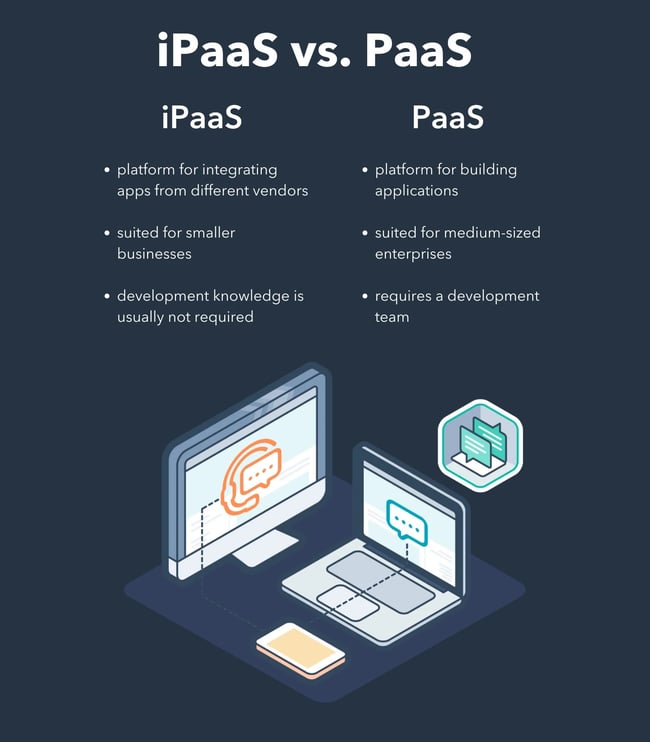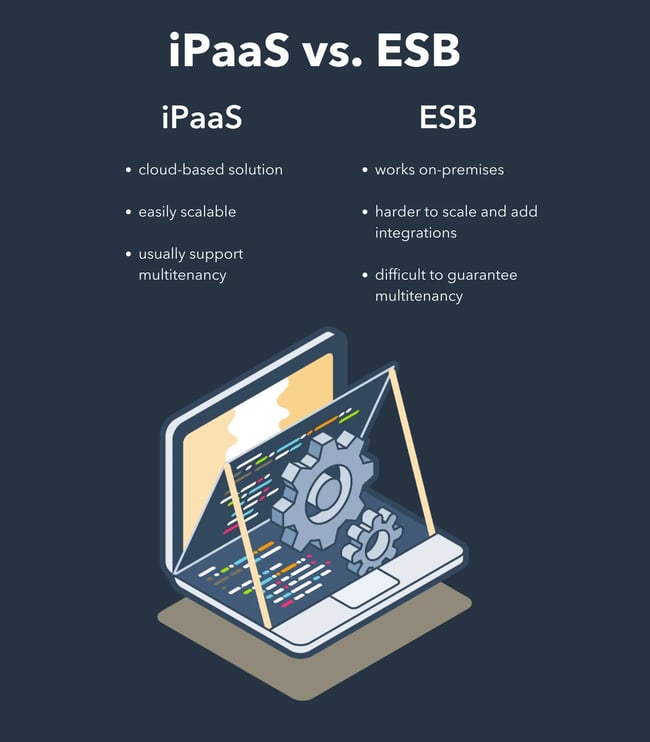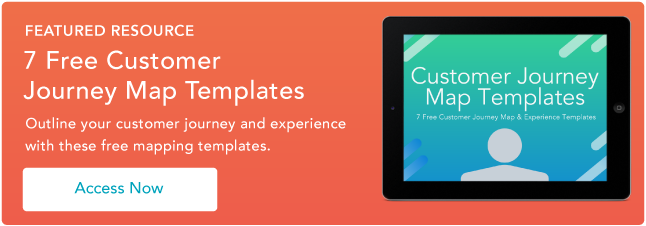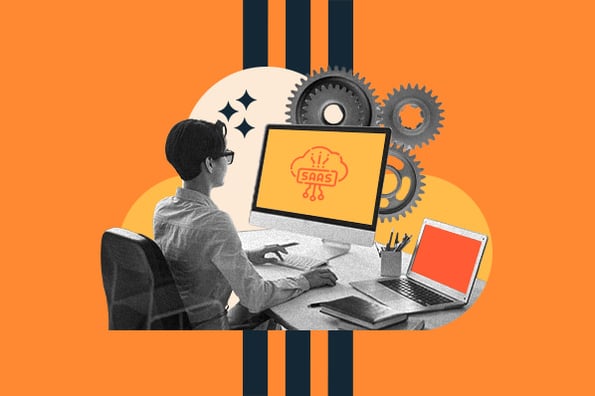You’ve likely heard of Software as a Service, or SaaS.
A SaaS company sells software to a user as a subscription. Along with that subscription, the software company provides technical support, customer service, and upgrade options to maximize their customers' ability to use their software.
HubSpot is an example of a SaaS company. We sell (darn good) marketing, sales, and service software so you can use them to grow your business. But there’s just one problem …
Over time, we’ve learned that things aren’t so linear and consumers rarely use just one software to satisfy all of their needs. Instead, they find a plugin here, some software there, and maybe even a widget until they have a smorgasbord of options that, together, create the perfect solution.
Consumer expectations have changed — they want instant feedback, immediate solutions, and access to everything they need to solve their problems.
From a business standpoint, it can be costly to add more tools to your existing software. An ever-increasing demand makes it hard to accommodate every customer need.
Additionally, most software companies have segregated systems themselves, pulling in data from the cloud and on-site systems to complete their own stack. Ascend2 found that 57% of marketers recognize integrating disparate technologies as the biggest barrier to success.
What happens when you have different systems operating on separate platforms that each play an integral role in your business? You become subject to data loss, disjointed information, and misalignment.
Between consumer expectations and internal systems, we need to find a way to create a more frictionless experience.
iPaaS is the solution.
iPaaS is a platform that connects otherwise disjointed systems to deliver a unified solution to customers. It acts as a conduit for communication between multiple systems, allowing for integration and data sharing. As we deepen our cloud dependency, iPaaS becomes integral to nearly every business model.
This guide will give you an overview of iPaaS, how it works, and its key benefits.
Chapters
Most companies run on various systems, especially between their sales, marketing, and service departments. iPaaS improves communication between different silos by integrating software to better share data within the organization.
iPaaS also allows a company to expand its offering without the need to build out more services. Instead, it can integrate with another software that already provides that service and offer a unified, more robust solution to customers.
For example, say you sell a scheduling software that helps hairstylists book, manage, and send appointment reminders to their clients. After developing your product, you realize that stylists also want their clients to be able to leave reviews and make payments through your software.
To meet your customers’ needs, you could either build out and add these features to your product, or you could use iPaaS to connect your scheduling software to existing review and payment software. The latter approach allows you to save time and money while expanding your service offering and giving your clients what they want.
This is just one of many potential iPaaS use cases to serve both customers and internal teams.
How does iPaaS work?
A software company will rely on iPaaS to supply the infrastructure for creating connections and deploying software applications within the cloud.
The software company sets the parameters for the types of connections that are allowed on the platform. These parameters could be in the form of an application programming interface (API), prebuilt connectors, or some other rule.
Once these rules are in place, iPaaS creates a central ecosystem to view, manage, and modify all data, infrastructure, and operations. This, in turn, allows entities to easily modify their product, share information, and provide solutions to their market.
iPaaS-Related Terms to Know
How do you distinguish between all service-oriented architecture (SOA)? Let’s cover the common cloud-based service business models out there to help you get a better grasp on what makes iPaaS unique.
Platform
A platform is the centralized component of all connections. HubSpot’s VP of Platform Ecosystem Scott Brinker defines a platform as a “hub, with spokes connecting other products to its center. The hub binds those disparate products together and orchestrates them in a common mission.”
Integration Platform
An integration platform creates connections between different applications and systems. This type of platform creates an environment for engineers to build upon.
Platform as a Service (PaaS)
A PaaS is a platform where the provider houses all of the elements that users need to deploy a particular software. Those elements include the servers, network, memory, database, and operating system.
Software
Software is a program that performs a specific set of tasks for a user.
Software as a Service (SaaS)
SaaS is a system where a user is provided with software to use on-demand. All maintenance, hosting, and deployment of that software is the responsibility of the software provider.
Integration as a Service (IaaS)
IaaS is a cloud-based model that allows for data integration between systems and third-party vendors. IaaS keeps all connected parties from having to create complex interdependencies and minimizes delays in data sharing.
Electronic Service Bus (ESB)
Electronic Service Bus is not denoted "as a service," but it could be considered a predecessor of iPaaS. An ESB is a middleware tool, which means that it works between applications the same way an iPaaS does. While iPaaS focuses on integration, an ESB has two functions: integrating and distributing data and messages.
Since ESBs were created before the cloud, they operate on-premises. They are still a reliable option for legacy systems.
iPaaS vs. PaaS
Although iPaaS and PaaS are only one letter apart, their functionalities are completely different.
A PaaS is basically a toolbox with generic features that developers can use to build their own applications.
PaaS supports different aspects of an application. Next to the development tools, PaaS vendors provide operating systems, business analytics, storage options, and data management solutions. With this last option, your developers might be able to build data integrations without too much hassle. Usually, companies working with this type of vendor are medium-sized enterprises.
Smaller businesses working with different applications will need an iPaaS at some point. The main reason is that those applications are not created by the same vendors. They are not connected natively, while the applications built on a PaaS usually live within the same environment.
Like PaaS, some iPaaS providers offer a very complete set of features. The difference is that those features are exclusively focused on integration.
Last but not least, to work with PaaS, you'll need a team of developers. On the other hand, iPaaS tools are usually created so that anyone in any team can create an integration with no coding required.

iPaaS vs. ESB
ESB and iPaaS are bridges between two applications, but they offer completely different solutions. The first distinction is that an ESB works on-premises, while iPaaS are cloud-based solutions. That doesn't mean that an ESB won't be able to integrate with a cloud application, but it makes the connection less viable.
Scalability is also different for ESB and iPaaS. In a company using iPaaS, integrating new applications is easy. iPaaS usually allows you to create as many connections as you want between the hundreds of applications they support. However, in a company working with ESB, it can take months to implement a new app.
Another variable to consider is multitenancy. This concept refers to the possibility of having several users accessing the same software. iPaaS and other cloud-based software usually support multitenancy. On the other hand, considering that ESB requires a piece of hardware to operate, multitenancy is very hard to guarantee.

Benefits of iPaaS
The rise of SaaS over the past two decades created a gap in the ecosystem that needed to be filled. That gap — the need for more integrated systems — has only become more apparent. iPaaS arose out of a need for an organized solution for deploying quick and seamless cloud-based solutions.
You can think about the benefits of iPaaS as two-fold: benefits to the company that employs iPaaS (internal) and benefits to the customers of the company that employs iPaas (external).
External Benefits
Software companies that employ iPaaS technology as part of their offering to consumers reap benefits from increased customer satisfaction. Consumers benefit from iPaaS in a number of ways.
A Single Solution
Instead of piecing together separate software to solve their needs, consumers can use a platform that connects to all of their software in one convenient cloud-based location, thereby eliminating the need to source and deploy their technology in different environments.
Organized Data
Consumers can access all of their data in one place and set rules for how that data is organized and accessed. So, while they’re working with different systems, all of those systems will render data in an easy-to-interpret manner. All of this makes data analysis, interpretation, and application easier and more accurate.
Improved Communication
One platform means a single source of truth. Data is being shared within the same ecosystem so no important information is lost and everyone has the same access, which leaves less room for misinterpretation.
Better Workflow
Less time switching between tools means more time for work and a central place where all of that work is done. A platform creates a more efficient environment for team dynamics and workflows.
Internal Benefits
Consumers aren’t the only ones who need integrated solutions. Companies also use disparate tools to run their businesses — think email providers, marketing software, document sharing, the list goes on. iPaaS brings these tools together to increase internal efficiency and improve workflows.
Here are some of the internal benefits of iPaaS.
Eliminate Silos
Third-party integrations can be created and deployed in various environments. This might not be an issue when there are only a few connections, however, as a company develops its offerings to become a more robust entity, integrations can become scattered, creating a mess where information is hidden from view or difficult to access and preventing a business from realizing critical insights.
Real-Time Processing
iPaaS allows for real-time data sharing and processing thereby eliminating delays in access and providing a quick and accessible solution.
Increased Efficiency
iPaaS mitigates confusion, data loss, and inconsistencies by creating a centralized system for the management of all parties involved.
Centralized Management
iPaaS creates a single, virtual view for managing all connections across the platform. Instead of having one individual or team manage different integrations, all of them can be accessed from a single console.
Multitenancy
Typically, each tenant that calls upon software requires its own instance. Similar to how every person on a call needs their own phone connection, an instance is created each time someone accesses the software. iPaaS allows for shared instances among tenants, eliminating overload, reducing costs, and increasing the speed of use.
Improved Security and Compliance
Security threats are inevitable in any environment, especially the cloud. iPaaS solutions offer fraud detection and intruder alerts. But the real benefit is that a centralized platform makes it easier to see where these threats are and respond adequately. In addition, a platform makes regulation compliance simple by implementing changes in a single environment.
Gartner iPaaS Magic Quadrant
Being that iPaaS is a newer technology, we look to objective opinions to check the validity, safety, and potential longevity of iPaaS vendors. Gartner iPaaS Magic Quadrant is that resource.
Gartner is an IT consulting firm and trusted resource for objective, qualitative industry research. According to Gartner, “Magic Quadrants offer visual snapshots, in-depth analyses and actionable advice that provide insight into a market's direction, maturity, and participants.”
The Gartner Magic Quadrant for Enterprise Integration as a Service looks at several iPaaS vendors in the space and details the strengths and cautions of each provider. It compares vendors like Boomi, Jitterbit, MuleSoft, Oracle, and SAP among several others to provide an objective view on the iPaaS environment and to give readers perspective on which solution would best fit their needs.
iPaaS Integration: Best Practices
iPaaS is an outstanding solution to integrate your business's technology ecosystem and to enhance its data flow. In order to get the most out of it, make sure to follow these best practices:
Have a data integration plan before implementing an iPaaS solution.
It's crucial to decide on a sound data integration plan before you begin syncing your data between multiple apps. For your plan to be successful, you need to:
- Define the goals you want to achieve with data integration. For example, you may want to integrate internal business data to have a holistic view of your business and build better analytics reports. Or you might want to integrate customer data from different applications to have a 360-degree view of your customers.
- Decide what kind of data you want to integrate. Once your data integration goals are set, you will have a much clearer idea of what kind of data you need to integrate. iPaaS platforms set algorithms to sync the same type of 'object' between apps. These objects can be names, emails, deals details, service tickets, etc. However, not every iPaaS can integrate all the objects of your apps. Determining which kind of data you need to integrate is key to decide which iPaaS to use.
- Find out where this data lives. In which applications are you storing this information? These are the tools you'll want to integrate with iPaaS. For example, if you want to sync customer data, find out which applications are collecting it across your business.
- Figure out how the data should flow. Decide how the data needs to flow between your tools. You might need one-way, trigger-action data pushes, or you might need a real-time, two-way synchronization.
Choose the right iPaaS solution for your business.
Different iPaaS tools suit different purposes. There are iPaaS tools that work perfectly to automate workflows between several tools, such as Zapier.
Once you've honed in on your integration needs, you'll be in a better position to decide which iPaaS tool will work for you. Take time to research your options thoroughly and determine which tool is the best option to help you achieve your data integration goals. We've included a list of top iPaaS vendors to help you get started with your search.
Set up your iPaaS tool properly.
iPaaS solutions hold a multitude of possibilities. Most of them will allow you to get really specific in your integration. Features such as rules and field mappings enable you to decide which groups of data to share between applications (in case you don't want to share your entire database). You can also pair different kinds of information between your tools.
For example, you can add a "New Customer" label to certain contacts in your CRM to identify your newest customers. You can then sync this label into your email marketing tool and automatically enroll these new customers in an onboarding email sequence that sends them all necessary resources, useful links, and who to contact within your organization if they have any questions or issues.
Manage your data.
While iPaaS will do a lot of the work for you when it comes to data management, it's still important to manually check in on your databases every so often.
This includes making sure your data is rid of duplicates, cleaning up invalid contact details, keeping your data fresh and deleting outdated information, and implementing consistent, company-wide procedures for data entry and management.
In addition, remember to check your syncs to make sure they are running smoothly and your data is flowing as it should.
iPaaS Vendors
iPaaS is a great solution to improve connection to and communication between all data and applications within your company. We’ve compiled this list of iPaaS vendors to help narrow your search for the perfect iPaaS partner. For more recommendations, see our full list of iPaas vendors.
Workato
Workato enables all your teams to create and easily maintain integrations between the different systems that power your business. This iPaaS solution comes equipped with 150,000+ "recipes" -- or automated workflows that connect apps and complete tasks based on a combination of apps, triggers, and actions -- so it's easy to hit the ground running with out-of-the-box integrations.
Dell Boomi
Dell Boomi offers a complete iPaaS solution with application and data integration, workflow automation, application deployment, API design, and B2B management all within a single master hub.
Cyclr
Cyclr's scalable Embedded iPaaS helps SaaS teams deliver & maintain more in-app integrations to their users. Create and publish integrations with low-code tools, or use a unified API to connect external data with your application.
Informatica
Informatica boasts customer loyalty and top-ranked iPaaS provider as their main advantages over other solutions. With a nod from Gartner and over seven thousand customers worldwide, the iPaaS vendor holds a top spot in the industry.
Celigo
Celigo offers an iPaaS solution that can handle everything from simple FTP integrations to complex integration needs. In addition, Celigo's application marketplace features vetted apps that solve for a multitude of business needs.
Jitterbit
Jitterbit understands the stress of building APIs between on-premise and cloud-based systems. The company has done well to empathize with businesses that lack the resources to build these integrations on their own and offers quick integrations with their platform as a result.
Blendr.io
Blendr.io offers a low-code visual builder to create complex enterprise-grade or standardized self-service integrations. In addition, Blendr.io provides a set of features to embed integrations into the UI of other SaaS platforms.
Mulesoft
Mulesoft offers cloud integration through its product called “CloudHub.” This solution offers multitenancy for integrations and API. The solution allows for deployment in eight different regions around the world, a number of workers, and out-of-the-box cloud security, and compliance. It also offers insights based on various metrics.
Zapier
Zapier is a well-known solution for connecting apps, automating workflows, and sharing data between otherwise disjointed systems.
iPaaS providers don’t stop there. You can view and compare dozens of vendors through a bit of research. Otherwise, Gartner has already done the work for you.
Get Integrated
As we continue to move towards cloud-based options, iPaaS becomes the most viable solution to eliminate the friction associated with disparate systems, and for connecting all applications and data between your organization and third parties. A single source that connects all of the systems we use to grow our businesses is an important step toward growing better. When we’re connected and in-sync, we can go further together.
Editor's note: This post was originally published in July 2020 and has been updated for comprehensiveness.






